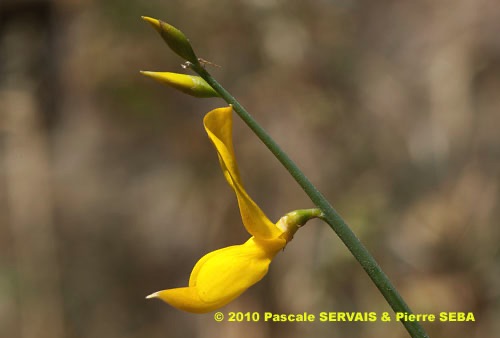
Spartium junceum L.
Fam. : Fabaceae
© Pascale SERVAIS & Pierre SEBA, 2018. Tilo Botanica: Flore de Tilos et du Dodécanèse / Flora of Tilos and of the Dodecanese
English translation by Brenda Bradbury, Howard Bradbury and Stéphane Léonard
Arbrisseau hermaphrodite, non épineux, à nombreuses tiges cylindriques, flexibles, lisses, vert bleuté comme le jonc.
Feuilles alternes, absentes ou éparses, insignifiantes, simples, linéaires à oblongues, éphémères, de 10 à 30 mm de long, presque sessiles, lisses au-dessus, couvertes de poils en dessous.
Fleurs à symétrie bilatérale, jaune vif, de 20 à 25 mm de long, réunies en grappes au sommet des tiges. Corolle papilionacée, à étendard dressé circulaire, à ailes étalées. Calice membraneux formé d’une seule partie. Ovaire supère.
Fruits, gousses aplaties, de 50 à 80 mm de long, poilues, devenant brunes et glabres à maturité.
___________________________
Shrub hermaphrodite, nonspiny. Stems numerous, cylindrical, flexible, smooth, bluish green like the rush.
Leaves alternate, absent or scattered, insignificant, simple, linear to oblong, short-lived, from 10 to 30 mm long, almost sessile, smooth on the upper part, covered in hairs on the lower part.
Flowers bilaterally symmetrical, bright yellow, from 20 to 25 mm long, joined together in racemes at the top of the stems. Corolla papilionaceous, with a circular erect standard, with spread out wings. Calyx membranous made of only one part. Ovary superior.
Fruits, flattened pods, from 50 to 80 mm long, hairy, becoming brown and glabrous at maturity.
Descripteurs / Identifying features
1
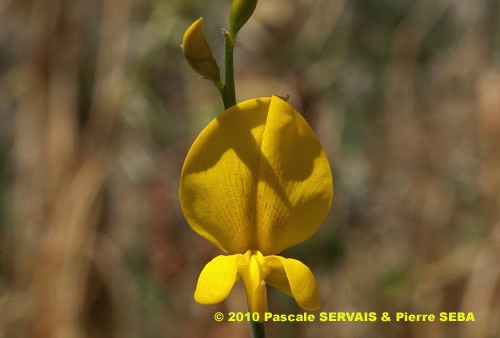
2
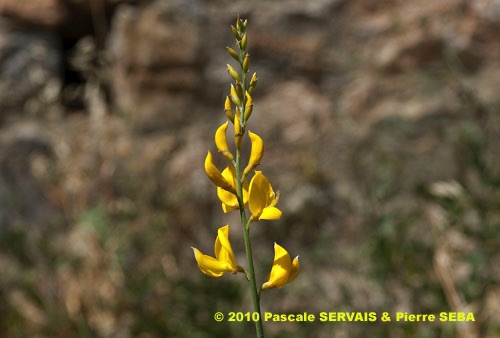
3
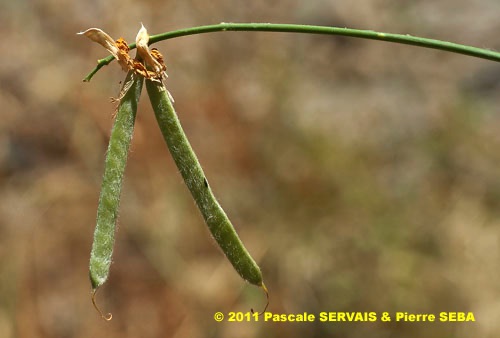
4
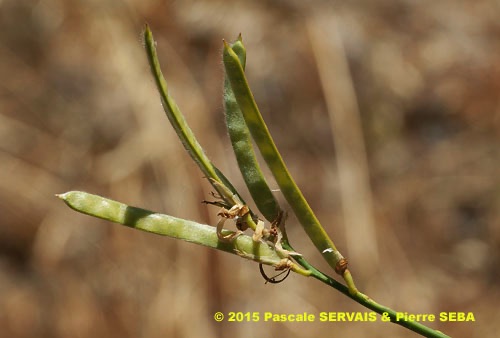
5
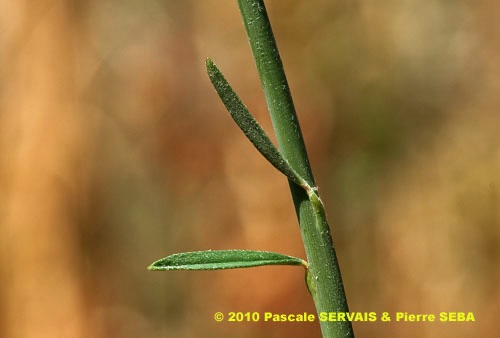
6
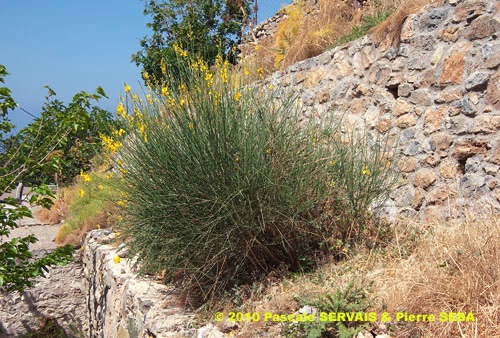
7
Étymologie / Etymology :
Spartium : emprunt du latin spartum, -i (nom) = le sparte (sorte de jonc),
nom donné à la plante par Pline, naturaliste latin mort en 79 apr. J.-C.,
forme latinisée du grec ancien σπάρτος, -ου (nom)
[ < σπάρτον, -ου (nom) = la corde ] = le sparte, le genêt, nom donné à
la plante par Théophraste, philosophe péripatéticien, disciple
d’Aristote, botaniste et naturaliste, mort vers 288 av. J.-C.,
en référence aux cordes qui étaient faites avec ses tiges tressées.
Junceum : emprunt du latin junceus, -a, -um (adj.) [ < juncus, -i (nom)
= le jonc ] = semblable au jonc, en référence aux tiges minces et
élancées.
Spartium : borrowed from Latin spartum, -i (noun) = spartion
(kind of rush), name given to the plant by Plinius, Latin naturalist died
in 79 AD, Latinized form of the Classical Greek σπάρτος, -ου (noun)
[ < σπάρτον, -ου (noun) = rope ] = spartion, broom, name given to the
plant by Theophrastus, peripatetic philosopher, disciple of Aristotle,
botanist and naturalist, died towards 288 BC, referring to the ropes
that were made with its braided stems.
Junceum : borrowed from Latin junceus, -a, -um (adj) [ < juncus, -i
(noun) = rush ] = similar to rush, rush like, referring to the thin and
slender stems.
Synonymes / Synonyms :
Cytisus junceus (L.) Vuk.
Genista acutifolia (Lindl.) Spach
Genista americana (Meyen) Spach
Genista hispanica Thell.
Genista juncea (L.) Scop.
Genista odorata Moench
Spartianthus junceus (L.) Link
Spartium acutifolium Lindl.
Spartium americanum Meyen
Spartium odoratum Dulac
Noms vernaculaires / Common names :
Noms français / French names :
Faux genêt d’Espagne — Geneste — Genêt d’Espagne — Gineste —
Joncier — Spartier — Spartier à tiges de jonc —
Spartier faux jonc — Spartion.
Noms grecs / Greek names :
Σπάρτιο το βουρλόμορφο — Σπάρτο — Σπάρτο βουρλόμορφο —
Σπάρτο το βουρλόμορφο — Σπάρτος — Σπάρτος βρουλόμορφος.
Noms anglais / English names :
Spanish broom — Weawer’s broom — Yellow Spanish broom.
Noms allemands / German names :
Binsen-Ginster — Binsenginster — Pfriemenginster —
Spanischer Ginster.
Noms espagnols / Spanish names :
Canarios — Gayomba — Genista de España — Hiniestra —
Retama de flor — Retama de los jardines — Retama de olor —
Retama macho — Retama olorosa.
Noms italiens / Italian names :
Ginestra comune — Ginestra di Spagna — Ginestra odorosa.
Habitat :
Lieux pierreux - Lieux incultes - Chemins.
Stony places - Waste ground - Waysides.
Île / Island :
Tilos.
Hauteur / Height range :
De 1 m à 3 m.
From 1 m to 3 m.
Floraison / Flowering time :
De février à août.
From February to August.
Groupe / Classification :
Dicotylédones.
Dicotyledons.
Pérennité / Lifespan :
Vivace.
Perennial.
Description :
Photo 1 :
Localisation / Location : Tilos, Megalochorio, Aghios Pandeleimonas
Date : 30/04/2010
GPS : Lat. 36,44805° N / Long. 27,30522° E / Alt. 271 m
Type : Photographie numérique / Digital Photograph (10 mégapixels)
Photo 2 :
Localisation / Location : Tilos, Megalochorio, Aghios Pandeleimonas
Date : 30/04/2010
GPS : Lat. 36,44805° N / Long. 27,30522° E / Alt. 271 m
Type : Photographie numérique / Digital Photograph (10 mégapixels)
Photo 3 :
Localisation / Location : Tilos, Megalochorio, Aghios Pandeleimonas
Date : 30/04/2010
GPS : Lat. 36,44805° N / Long. 27,30522° E / Alt. 271 m
Type : Photographie numérique / Digital Photograph (10 mégapixels)
Photo 4 :
Localisation / Location : Tilos, Megalochorio, Aghios Pandeleimonas
Date : 07/06/2011
GPS : Lat. 36,44804° N / Long. 27,30522° E / Alt. 271 m
Type : Photographie numérique / Digital Photograph (10 mégapixels)
Photo 5 :
Localisation / Location : Tilos, Megalochorio, Aghios Pandeleimonas
Date : 07/06/2011
GPS : Lat. 36,44804° N / Long. 27,30522° E / Alt. 271 m
Type : Photographie numérique / Digital Photograph (10 mégapixels)
Photo 6 :
Localisation / Location : Tilos, Megalochorio, Aghios Pandeleimonas
Date : 30/04/2010
GPS : Lat. 36,44805° N / Long. 27,30522° E / Alt. 271 m
Type : Photographie numérique / Digital Photograph (10 mégapixels)
Photo 7 :
Localisation / Location : Tilos, Megalochorio, Aghios Pandeleimonas
Date : 28/04/2010
GPS : Lat. 36,44805° N / Long. 27,30522° E / Alt. 271 m
Type : Photographie numérique / Digital Photograph (10 mégapixels)

Google Maps
Google Maps
Google Maps
Google Maps
Google Maps
Google Maps
Google Maps